Experiments with a quartz supergenerator. Encyclopedia of radio electronics and electrical engineering

Encyclopedia of radio electronics and electrical engineering / Knots of amateur radio equipment. Generators, heterodynes
 Comments on the article
Comments on the article
Figure 1 shows the scheme that was used for the experiments. The frequencies of the quartz in the studies were 14.218 MHz. The main element that was changed in the experiment is the inductor L. A 22 kΩ resistor was added in parallel to it to eliminate frequency dips within the range. The transistor in the generator has a cutoff frequency of 80 MHz. As a buffer stage - a field-effect transistor amplifier. The bias resistor Rb for the first transistor is 100 kΩ (with this value, the emitter current is 9 mA). Capacitors C1 and C2 150 pF each. At the end of the experiment, there was an attempt to change the values of Rb, C1 and C2. The variable capacitor is plate-type and has a value from a few pF to 100 pF. The transformer T is wound on a ferrite ring with a diameter of 7 mm. The winding is made of folded and twisted three wires PELSHO 0.2 and contains 3...4 turns. The ends of each winding are connected according to the scheme.
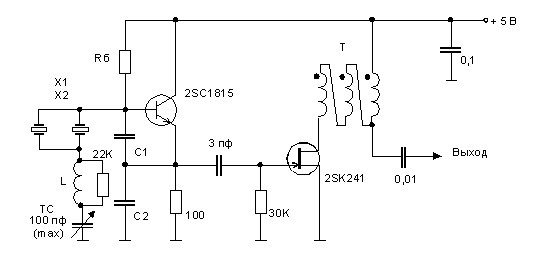
Ris.1
Figure 2 shows the generator frequency adjustment ranges when the capacitance of the TS capacitor changes from the minimum value to 100 pF. For measurements, we used a set of inductors L with ratings of 5.6, 8.2, 10, 10.39, 11, and 12 μH. To obtain an inductance of 10.39 μH, two 10+0.39 μH coils connected in series were used, and for 11 μH, 10+1 μH. For clarity, the curve (X1 only) for a generator with one quartz is shown. As can be seen from the graph, for a conventional generator, the frequency changes slightly with increasing inductance. At the same time, for the supergenerator, the frequency adjustment range rapidly increases up to 300 kHz (!) with L=12 μH. However, we must be careful with such a wide frequency adjustment range due to the deterioration of stability.
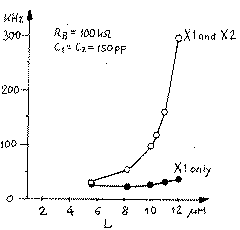
Ris.2
Figure 2 shows the frequency drift for three inductance values L=10, 10.39, and 11 µH. In this case, both quartz are connected in parallel, and the capacitance of the variable capacitor is TC=100 pF. The measurements were carried out 25 min after soldering the corresponding circuit. After that, the power to the generator was turned on and the time was recorded. As can be seen, acceptable stability over time was observed for L=10 μH. For values with L=10.39 and 11 µH, the frequency drifts over a wider range. This is most dependent on the temperature coefficient of the inductances. Therefore, in my practice, I settled on the maximum value of L = 10 µg. Ultimately, you can get better stability with longer warm-up times and using inductors with small temperature coefficients.
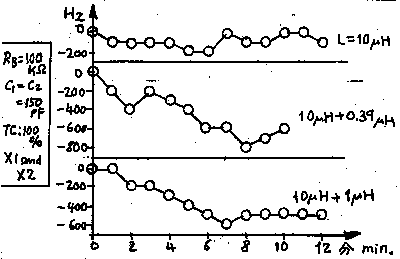
Ris.3
Now I change capacitances C1 and C2 a little. All other parameters are set as follows: Rb=100 kOhm, L=10 µH, and X1, X2 in parallel connection. Fig.4 shows the frequency range as a function of capacitance C1 and C2. C1 and C2 changed simultaneously. The graph shows that the frequency range is wider with increasing capacitance. Measurements with C1=C2=330pF were not possible because Vout (output voltage at the counter) was too low as shown in Fig.5. The values of C1 and C2 in 100 and 150 pF are the most acceptable in practice in this circuit.
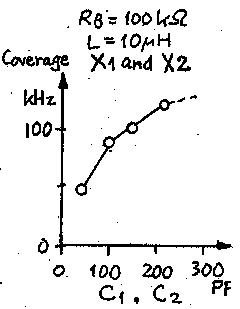
Ris.4
And, finally, the value of the base resistor Rb was changed. The other elements were: C1=C2=150pF, L=10uH, and X1, X2 in parallel. Initially, Rb was set to 100 kΩ with an emitter current of 9 mA. This time, Rb is set to 200 kΩ, with the emitter current reduced to 5.2 mA. The frequency range did not change although Vout (output voltage) decreased from 0.7 V to 0.3 V. Further, Rb was increased to 470 kΩ, the emitter current decreased to 2.4 mA. However, Vout was too low, less than 0.1 V. Therefore, the counter could not measure the frequency of the signal.
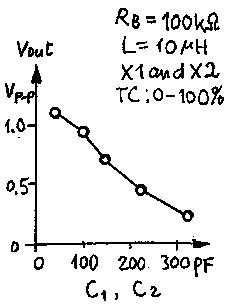
Ris.5
Finally, a frequency range of about 100 kHz was obtained with L=10 µH, C1=C2=150 pF, X1 and X2 connected in parallel and Rb=100 kΩ. The stability was acceptable, but worsened as the coil inductance L increased. The frequency range was wider because C1 and C2 were set to high values but did not depend on the bias resistor Rb.
It should be emphasized that these results are more or less specific and depend on the quartz used in this experiment. The optimum was estimated for L, C1 and C2 and may differ from the values obtained in this experiment if the quartz has other parameters or other frequencies. Therefore, you can experiment to optimize the parameters for your quartz resonator.
Author: MINOWA, Makoto, 7N3WVM; Translation and publication: N. Bolshakov, rf.atnn.ru
 See other articles Section Knots of amateur radio equipment. Generators, heterodynes.
See other articles Section Knots of amateur radio equipment. Generators, heterodynes.
 Read and write useful comments on this article.
Read and write useful comments on this article.
<< Back
 Latest news of science and technology, new electronics:
Latest news of science and technology, new electronics:
Artificial leather for touch emulation
15.04.2024
In a modern technology world where distance is becoming increasingly commonplace, maintaining connection and a sense of closeness is important. Recent developments in artificial skin by German scientists from Saarland University represent a new era in virtual interactions. German researchers from Saarland University have developed ultra-thin films that can transmit the sensation of touch over a distance. This cutting-edge technology provides new opportunities for virtual communication, especially for those who find themselves far from their loved ones. The ultra-thin films developed by the researchers, just 50 micrometers thick, can be integrated into textiles and worn like a second skin. These films act as sensors that recognize tactile signals from mom or dad, and as actuators that transmit these movements to the baby. Parents' touch to the fabric activates sensors that react to pressure and deform the ultra-thin film. This ... >>
Petgugu Global cat litter
15.04.2024
Taking care of pets can often be a challenge, especially when it comes to keeping your home clean. A new interesting solution from the Petgugu Global startup has been presented, which will make life easier for cat owners and help them keep their home perfectly clean and tidy. Startup Petgugu Global has unveiled a unique cat toilet that can automatically flush feces, keeping your home clean and fresh. This innovative device is equipped with various smart sensors that monitor your pet's toilet activity and activate to automatically clean after use. The device connects to the sewer system and ensures efficient waste removal without the need for intervention from the owner. Additionally, the toilet has a large flushable storage capacity, making it ideal for multi-cat households. The Petgugu cat litter bowl is designed for use with water-soluble litters and offers a range of additional ... >>
The attractiveness of caring men
14.04.2024
The stereotype that women prefer "bad boys" has long been widespread. However, recent research conducted by British scientists from Monash University offers a new perspective on this issue. They looked at how women responded to men's emotional responsibility and willingness to help others. The study's findings could change our understanding of what makes men attractive to women. A study conducted by scientists from Monash University leads to new findings about men's attractiveness to women. In the experiment, women were shown photographs of men with brief stories about their behavior in various situations, including their reaction to an encounter with a homeless person. Some of the men ignored the homeless man, while others helped him, such as buying him food. A study found that men who showed empathy and kindness were more attractive to women compared to men who showed empathy and kindness. ... >>
 Random news from the Archive Random news from the Archive Cheap drone that doesn't need fuel
06.05.2019
In the modern world, drones have turned out to be so in demand that the technology for their creation is developing by leaps and bounds. Therefore, it is not surprising when the next drone makes a splash, especially when it comes to military developments. However, Phoenix, the new drone in service with the UK, could fundamentally change the entire modern industry.
With a length of 15 meters and a wingspan of just 10,3 meters, the Phoenix looks like a small flying bomb covered in solar panels. The press release notes that the drone "uses a variable buoyancy propulsion system" to move through the air. In fact, this means that in flight, the Phoenix sucks air into the internal inflatable tank, which makes it heavier and dives forward, losing altitude. Then the air is released and the drone moves forward again, but with a climb. To facilitate this process, there is always a supply of helium or hydrogen on board.
Since the Phoenix does not have an internal combustion engine and no need for fuel, in theory the drone could stay at the right altitude indefinitely and act as a flying sensor or communications hub for the military. A fuselage with carbon fiber wings costs so little (especially compared to other military drones) that the designers who designed it jokingly refer to the drone as a "disposable" drone.
It is currently stated that Phoenix can be used as a satellite alternative - it will allow safe signal transmission over a distance of a thousand kilometers. In addition, the drone can act as a platform for tracking the movements of the enemy. The cheapness of the drone allows mobile units to keep many of these devices in stock, deploying them when needed.
|
 Other interesting news:
Other interesting news:
▪ Smart fabric from Apple
▪ Harm of Wi-Fi networks
▪ Apple to switch to recycled cobalt, gold, tin and rare earths
▪ The world's first optical fuse from MOLEX
▪ Tennis racket electronic shock absorber
 News feed of science and technology, new electronics
News feed of science and technology, new electronics
 Interesting materials of the Free Technical Library:
Interesting materials of the Free Technical Library:
▪ radio section of the website. Article selection
▪ article Passion-muzzle. Popular expression
▪ Why was King Richard I of England nicknamed the Lionheart? Detailed answer
▪ article Aralia high. Legends, cultivation, methods of application
▪ article Installation and power wires. Encyclopedia of radio electronics and electrical engineering
▪ article Radio station at 420 ... 435 MHz. Encyclopedia of radio electronics and electrical engineering
 Leave your comment on this article:
Leave your comment on this article:
 All languages of this page
All languages of this page
Home page | Library | Articles | Website map | Site Reviews

www.diagram.com.ua
2000-2024







 Arabic
Arabic Bengali
Bengali Chinese
Chinese English
English French
French German
German Hebrew
Hebrew Hindi
Hindi Italian
Italian Japanese
Japanese Korean
Korean Malay
Malay Polish
Polish Portuguese
Portuguese Spanish
Spanish Turkish
Turkish Ukrainian
Ukrainian Vietnamese
Vietnamese





 Leave your comment on this article:
Leave your comment on this article: